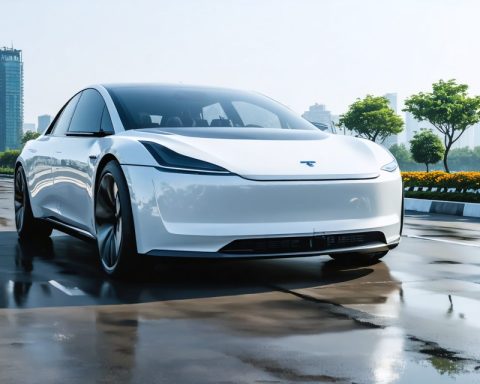- The US-China trade dispute casts uncertainty over global markets, driven by shifting policies and unexpected developments.
- The US has implemented tariffs targeting Chinese imports, with some temporary exemptions for sectors like smartphones and semiconductors.
- President Trump is committed to a hardline tariff approach, carving out exceptions for sectors like pharmaceuticals but hinting at more specific tariffs looming.
- China’s response is marked by strategic diplomacy and regional alliances, highlighting its stability amidst the trade tensions.
- US financial markets show instability, with investor concerns and fluctuating consumer confidence reflecting the impact of tariff decisions.
- The White House maintains that the policy is activating global trade negotiations despite market anxiety.
- The trade conflict underscores the necessity for adaptability and resilience in international trade, influencing the global economic landscape.
Amid fiery rhetoric and strategic maneuvering, the ongoing trade dispute between the United States and China continues to cast uneasy shadows over global markets. Recent developments have painted a volatile picture, marked by shifting policies and unexpected twists. With economic powerhouses locked in a relentless tug-of-war, the world watches with bated breath.
Policymaking in Washington has been a whirlwind of decisions, none more striking than the sweeping tariffs introduced by the US that specifically target Chinese imports. Initial relief flickered briefly on the horizon as exemptions were announced for crucial sectors like smartphones and semiconductors. Yet, this glimmer quickly dimmed when clarifications emerged. American tech titans, who initially felt a touch of reprieve, were jolted by the assertion that no product would be entirely unscathed by tariffs. A mere shuffle into a different category offered scant comfort.
President Donald Trump’s stern declaration that no nation would “get off the hook” suggests a firm commitment to his hardline stance. His administration has carved out sectors like pharmaceuticals for tariff immunity but intertwined this with the ominous hint of sector-specific tariffs hovering over items integral to national defense. The clarity promised in imminent announcements leaves industries bracing for impact.
From Beijing, China’s response has been both pragmatic and defiant. Even as it navigates economic skirmishes, it showcases its neighborly prowess. Chinese leader Xi Jinping’s diplomatic jaunt through Southeast Asia underscores this narrative, presenting China as a beacon of stability amid Washington’s unpredictability. Alliances with manufacturing giants like Vietnam further illustrate China’s strategic recalibration in response to tariff turbulence.
Back in the US, financial markets quiver under the cascading effects of tariff announcements. Investors are wary, and consumer confidence wavers, revealing the tangible costs of this economic brinkmanship. Wall Street’s discontent reverberates loudly, with prominent figures once allied with the administration vocalizing their concerns over the economic strategies unfurling.
The White House, however, remains undeterred, lauding the policy’s fruits. They assert that nations are queuing to forge trade negotiations, spurred into action by the looming deadline of paused tariffs. Yet, the real test lies ahead as these negotiations unfold against the backdrop of an unwaveringly complex global trade landscape.
In this era of economic uncertainty and strategic repositioning, one thing is clear: the trade chess game between the US and China has redefined the global economic narrative, with ramifications that will resonate far beyond immediate fiscal quarters. The key takeaway? Prepare for a future where adaptability and resilience in international trade become more crucial than ever.
The Ongoing US-China Trade Dispute: What You Need to Know Now
Understanding the Current US-China Trade Dispute
The trade dispute between the United States and China is a complex, evolving phenomenon with significant global implications. At its core, this ongoing conflict stems from both countries imposing tariffs on each other’s goods, impacting economic landscapes worldwide.
Key Facts and Insights:
1. Sector-Specific Tariffs: The US has been strategic in its approach, imposing tariffs that aim to protect industries crucial to national security, such as the defense sector. On the other hand, certain sectors like pharmaceuticals are receiving exemptions, illustrating targeted economic strategies ([source](https://www.brookings.edu)).
2. Shift in Import Sources: As a direct consequence of tariffs, American companies are exploring alternative supply chains outside of China. Southeast Asian countries like Vietnam and Indonesia have become prominent hubs for manufacturing and exports, benefiting from China’s redirected alliances.
3. Consumer Impact: Tariffs inherently increase the cost of imports, which gets passed to consumers. This can lead to inflationary pressures, impacting purchase behaviors and consumer confidence ([source](https://www.cfr.org)).
4. Effects on Tech Industry: The tech sector, though initially anticipated to gain exemption, remains heavily affected. Products like semiconductors and smartphones face significant price hikes, affecting both corporate profitability and consumer pricing strategies.
Market Forecasts and Industry Trends:
– The trade dispute accelerates the diversification of supply chains. While this creates short-term disruptions, it presents long-term opportunities for emerging economies.
– Experts predict a shift towards more regional trade agreements as countries seek to reduce reliance on US-China trade entanglements.
– Financial markets are expected to remain volatile as investors adjust to the ever-changing trade environment. Wall Street’s response to policy changes emphasizes the importance of strategic market monitoring ([source](https://www.wsj.com)).
Real-World Use Cases:
– Businesses Shifting Supply Chains: Companies like Apple and Nike are exploring manufacturing bases outside China to mitigate tariff impacts, evaluating logistics, labor costs, and production capabilities in regions like Southeast Asia.
– Investment Strategies during Volatility: Investors are advised to diversify portfolios, focusing on emerging markets and sectors less affected by the trade conflict.
Controversies and Criticism:
– Critiques argue that tariffs could lead to reduced economic growth, both in the US and globally. The approach has sparked divisions among policymakers and industry leaders, questioning its long-term viability.
Quick Tips for Businesses and Consumers:
– For Businesses: Evaluate and diversify supply chains to include alternative regions to mitigate risks. Keep abreast of policy changes and adapt pricing strategies accordingly.
– For Consumers: Monitor product prices, especially for imported goods, and consider substitutes if significant price increases occur.
Conclusion and Recommendations:
In light of the ongoing US-China trade dispute, adaptability remains key. Businesses should prepare for continued volatility by diversifying supply chains and exploring new markets. Consumers, meanwhile, should stay informed about tariff-affected products to make cost-effective purchasing decisions.
For further insights and updates on global trade dynamics, visit Economist or Reuters.





















